|
The
|
THE BURGENLAND BUNCH NEWS - No. 256 June 30, 2015, © 2015 by The Burgenland Bunch All rights reserved. Permission to copy excerpts granted if credit is provided. Editor: Thomas Steichen (email: tj.steichen@comcast.net) Archives at: BB Newsletter Index Our 19th Year. The Burgenland Bunch Newsletter is issued monthly online. It was founded by Gerald Berghold (who retired from the BB in the Summer of 2008 and died in August 2008). |
Current Status Of The BB: * Members: 2351 * Surname Entries: 7613 * Query Board Entries: 5467 * Staff Members: 17 |
This newsletter concerns: 1) THE PRESIDENT'S CORNER 2) ISLAM IN AUSTRIA AND BURGENLAND 3) YOUTUBE RELATIVE, AN ILLUSTRATED EXPLANATION (by Richard Potetz) 4) RESEARCHING THE EBERHARDT FAMILY (by Kathie Everhard) 5) EMIGRATION FROM THE BURGENLAND TO THE LEHIGH VALLEY (by Mahlon H Hellerich) 6) HISTORICAL BB NEWSLETTER ARTICLES: - MORE ON HISTORICAL TERMS - A FEW MORE TERMS 7) ETHNIC EVENTS 8) BURGENLAND EMIGRANT OBITUARIES (courtesy of Bob Strauch) |
1) THE PRESIDENT'S CORNER (by Tom Steichen)  Concerning
this newsletter, after the bits and pieces here in my "Corner," Article 2 is a piece about
Islam in Burgenland, an article motivated by a recent rewrite of the Austrian "Islam
Law" guaranteeing the right of Islamic worship and religious education in state schools, as
is provided for other faiths. Concerning
this newsletter, after the bits and pieces here in my "Corner," Article 2 is a piece about
Islam in Burgenland, an article motivated by a recent rewrite of the Austrian "Islam
Law" guaranteeing the right of Islamic worship and religious education in state schools, as
is provided for other faiths.Articles 3 is by Richard Potetz and is (sort of) a follow-up on a YouTube video I shared last month. Richard calls it An Illustrated Explanation that shows how he is related to the cousin featured in that video. I think you will enjoy it. Article 4 is an invited piece wherein Kathie Everhard tells about Research into the Eberhardt Family in the Lehigh Valley. Kathie and husband Larry are planning a Burgenland trip so are doing their homework first, though they are residents of Ohio so are a little far from home. Article 5 is by the late Dr. Mahlon H. Hellerich, who was Archivist of Lehigh County, PA, from 1974 to 1984 and married to a daughter of Burgenland emigrants. His article was shared by his daughter and is about Emigration from the Burgenland to the Lehigh Valley. It was written for the program of the "Centennial of the Migration from Burgenland to the United States 1875–1975," held in Allentown, PA, in 1975. The remaining articles are our standard sections: Historical Newsletter Articles, and the Ethnic Events and Emigrant Obituaries sections.  Church
Names: I mentioned that I had started a campaign a few months ago to identify all
church/temple/synagogue names in Burgenland. This month, BB member Johnny Santana,
of Brentwood, NY, and researcher of surnames Tomiser and Baliko of Jabing, wrote in with
material on St. Anne's Catholic church in Jabing, where his great-grandfather, Ignaz Tomiser,
once served as an altar boy. He shared St. Anne's website (http://www.pfarre-jabing.at/index.php)
as well as a .pdf copy of the parish history, "Geschichte der Pfarrkirche zur hl Anna". Church
Names: I mentioned that I had started a campaign a few months ago to identify all
church/temple/synagogue names in Burgenland. This month, BB member Johnny Santana,
of Brentwood, NY, and researcher of surnames Tomiser and Baliko of Jabing, wrote in with
material on St. Anne's Catholic church in Jabing, where his great-grandfather, Ignaz Tomiser,
once served as an altar boy. He shared St. Anne's website (http://www.pfarre-jabing.at/index.php)
as well as a .pdf copy of the parish history, "Geschichte der Pfarrkirche zur hl Anna".
In addition, he shared another .pdf file, "Bundesdenkmalamt Österreich.pdf" (from the Austrian Federal Monuments Office) that provided information about churches in villages throughout the Oberwart district. This led to a number of small corrections in what I previously reported. My thanks to Johnny for this information. Like Johnny, do write if you can provide additional or corrected information on Burgenland (and adjacent) church names. HUNGARICANA: László Békési wrote to point out a new Hungarian site that he thinks could be of help to a lot of our BB members; I agree! The main website link is http://hungaricana.hu/hu/ or, for English, http://hungaricana.hu/en/. This website is described as "the common website of Hungarian archives, museums and libraries, operated by the Hungarian Library of Parliament (Országgyűlési Könyvtár)." Most documents are in Hungarian, Latin or German. The main databases are:
Perhaps the most interesting database is the images of the 1767 Urbarium, ordered by Maria
Theresa. It begins at page:
http://archives.hungaricana.hu/en/urberi/.
I replied (in part): "I’m copying Paul Zotter and our DNA guys on this reply
and will insert something in the next NL about it. I appreciate your explanation. I do
understand the problem, as we used to have the same problem when we sent out the email-based
version of the newsletter. AOL was a particularly frequent “deflector” of legitimate messages!"
|
2) ISLAM IN AUSTRIA AND BURGENLAND  The following was motivated by an April 7th New York Times article entitled "Austria’s Islamic Reforms" by Soeren Kern (see austrias-islamic-reforms.html). Additional material comes from Wikipedia's "Islam in Austria" page, along with small bits from other sources. My thanks to Margaret Kaiser for pointing out the article that led to this note. In February, the Austrian Parliament amended it’s century-old “Islam Law.” The new legislation, though controversial, is intended to promote a moderate, homegrown Islam that is compatible with democratic values. The original "Islamgesetz" (Islam Law), known as the "Anerkennungsgesetz" (Act of Recognition), was passed in 1912 under the rule of the Habsburg Emperor Franz Joseph and sought to integrate those Muslims who became part of the Austro-Hungarian Empire in 1908 following the annexation of Bosnia and Herzegovina. Austria-Hungary extended Muslims the same right of worship as other official religions, and granted state protection to Islamic customs, doctrines and institutions. Under the law, Muslims, like Catholics, Jews and Protestants, were guaranteed wide-ranging rights, including religious education in state schools. However, the empire’s breakup following World War I left just a few hundred Muslims in Austria, and the Islamgesetz became largely irrelevant. That began to change in the 1960s and 1970s, with the arrival of thousands of guest workers from the Balkans and Turkey. In the 1990s, refugees from Bosnia and Kosovo followed. Most recently, Austria absorbed asylum-seekers from Syria, Afghanistan and Iraq. The vast majority of Muslims in Austria belong to the Sunni denomination and Austria now has the highest percentage of Muslims in Western Europe. Given the natural expansion among now second- and third-generation immigrant families, about half of the country’s Muslims are Austrian nationals, with the total number of Muslims exceeding 550,000—about 7 percent of the Austrian population. Only when the "Islamische Glaubensgemeinschaft in Österreich" (Community of Muslim Believers in Austria) was founded in 1979 did the 1912 law (and its shortcomings) again become relevant. This organization is entitled to present religious education classes in state schools and to collect a "church tax" (but so far has not initiated a tax). The current reforms follow years of lobbying by Muslim leaders, who argued that their people have effectively remained second-class citizens. The updated law confirms Islam’s official status and expands Muslim rights. Muslims will be allowed time off from work to observe Islamic holidays and be able to receive spiritual care and halal meals in hospitals, prisons and the armed forces. The law also establishes a theological program for Imams at the University of Vienna, where instruction will reinforce European social values. But other reforms, which Vienna says are aimed at counteracting extremism, are contentious. The updated law bans other countries from financing Islamic groups, and bars foreign clerics from leadership positions in Austrian mosques. All Imams must speak German, and Muslim clergy must prove “professional suitability,” either by completing the University of Vienna program, or demonstrating equivalent training. Stressing that Austrian law takes precedence over Shariah, it requires Muslim organizations to show a “positive attitude toward society and state,” or risk closure. Austria’s reforms have now set a precedent in Europe, where concerns about extremism have been echoed by other governments. The French have voiced disapproval of a reliance on foreign funding by France’s Muslim institutions. German and Swiss officials have also expressed interest in similar financing controls. Austrian reactions have been mixed. Muslims have generally—if grudgingly—accepted the reforms. The Islamic Religious Community in Austria, an umbrella group that helped draft the amendments, conceded that the outcome “probably comes closest to the needs of both parties.” But because Austria’s Christian and Jewish groups do not face language restrictions and may receive foreign financing, others find these measures highly discriminatory. On the opposite end of the spectrum, the anti-immigration Freedom Party opposed the law, deeming it ineffective in curbing extremism. But these measures are intended to respond to a real concern. A small but growing number of Austrian Muslims is embracing radical Islam; officials say nearly 200 have left the country to join jihadist movements in the Middle East. The reforms acknowledge the current climate while striking a balance between civil liberties and national security. One century ago, Austria officially recognized Islam. Today it is again at the forefront of Muslim integration. As for Burgenland, its percentage of Muslims (1.4%) is well below average for Austria and no mosques exist in its territory (the nearest mosque is in Vienna). Land Vorarlberg (8.36%) and Vienna (7.82%) have the highest proportion of Muslims, which generally diminish as you move southeast. As of 2007, there were around 4,000 Muslims in Burgenland with about 680 being students receiving religious instruction in Burgenland schools. Such courses have been available since 1987 and are organized by the "Islamic Believers Association" in Vienna. |
3) YOUTUBE RELATIVE, AN ILLUSTRATED EXPLANATION (by Richard Potetz) Often we don’t know them, but most Burgenland Bunch members have relatives living in Austria. Although we now live in different places and speak different languages, we share, for all time, ancestors who lived their lives in the place that became Burgenland. Last month, the Burgenland Bunch Newsletter included a link to the music of my talented Austrian relative, Christian Bakanic, whom I’ve never met. An illustrated explanation of how Christian Bakanic and I came to be related begins with a group photo taken at the home of our shared ancestors, Johann and Rosina Sucher: 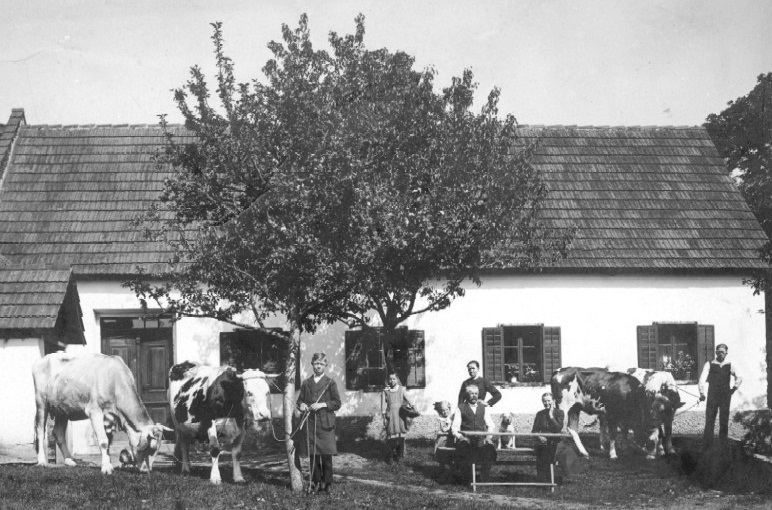 Sucher Family, with cows, about 1923 My grandparents, in this photo, had 94 descendants the last time we counted (in 2010), split evenly between Austria and America. They have even more descendants now; great-great-granddaughters were born in Connecticut and Maryland just this year. 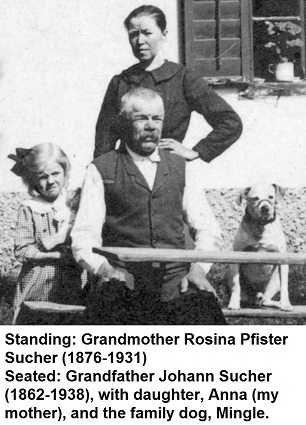 Enlarged
sections of the group photo are shown below to explain this story, beginning with one that
better shows my grandparents. Enlarged
sections of the group photo are shown below to explain this story, beginning with one that
better shows my grandparents.Oddly, the house in the photo was only 30% in Burgenland. When Grandmother Rosina was born in that home in 1876, the address was Welten 75, Vas County, Hungary. The 1858 Welten Houselist shows house 75 owned by the grandfather of Rosina, Johann Pfister (1805-1881). For many generations my ancestors living in that home were baptized, married and buried at the church in Sankt Martin a/d Raab, inside the place that became Burgenland. But then, in 1906, a land survey revealed their home was mostly in Schiefer, Austria. The border line did not change, just the address of that house, from Welten house 75 to Schiefer house 60. The house had been built originally as a guard-post between Austria and Hungary, purposely built to straddle the old Austria/Hungary border. Rosina and Johann Sucher had eight children, all born in the same bedroom but, because of the address change, the first four were born in Hungary and the next four were born in Austria. A genealogist would have gone crazy had that address change occurred before memories faded, with half of the children baptized at the church in Sankt Martin a/d Raab and half baptized at the church in Fehring: Rosa Sucher Heyne b. 1896 Welten 75 d. 1986 Connecticut John Sucher b. 1898 Welten 75 d. 1931 Chicago Joe Sucher b. 1900 Welten 75 d. 1978 Connecticut Franz Sucher b. 1904 Welten 75 d. 1905 Welten 75 Hermann Sucher b. 1907 Schiefer 60 d. 1945 Russia Franz Sucher b. 1909 Schiefer 60 d. 1997 Schiefer 60 Mary Sucher Huber b. 1912 Schiefer 60 d. 2004 Connecticut Anna Sucher Potetz b. 1918 Schiefer 60 d. 2013 Connecticut 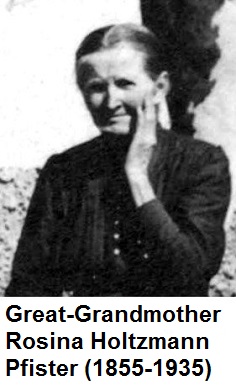 The
photo was taken at the height of the mass migration from Burgenland. Almost seven thousand
people left Burgenland in 1923. But those are just numbers. Numbers alone do not tell the story
of how families were changed by that mass migration. The Sucher family in the photo is an
example; most of my grandparents’ children, as listed above, went to America. In addition, most
of my grandmother’s siblings, children of their widowed mother, Rosina Holtzmann Pfister
(also in the photo), went to America too. The
photo was taken at the height of the mass migration from Burgenland. Almost seven thousand
people left Burgenland in 1923. But those are just numbers. Numbers alone do not tell the story
of how families were changed by that mass migration. The Sucher family in the photo is an
example; most of my grandparents’ children, as listed above, went to America. In addition, most
of my grandmother’s siblings, children of their widowed mother, Rosina Holtzmann Pfister
(also in the photo), went to America too.We think we know why animals were included in the photo. The two oldest children had gone to America, so they’re not in the photo. The third child, Joe, on the right holding the cows, would follow his older siblings by going to America a few months later. It’s the fifth child, Hermann, an animal lover, also not in the photo as he had gone to Graz to learn to be a tailor, who would have been the right age to ask for a photo of the “entire family.” The dog, Mingle, was so strongly bonded with Hermann that, when he saw Hermann arriving home for a visit, he jumped shoulder high. 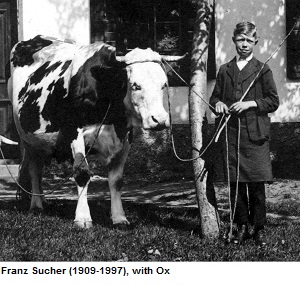 Franz,
the sixth child of Rosina and Johann, stayed in that home and remained a farmer. On the above
list of children, you can see the fourth child was also named Franz, sadly dying before age one.
At that time, childhood death was not unusual. In fact, with seven of eight children living to
adulthood, the Sucher family was successful. Reusing the name of a passed child is seen often in
old Burgenland parish records. Franz,
the sixth child of Rosina and Johann, stayed in that home and remained a farmer. On the above
list of children, you can see the fourth child was also named Franz, sadly dying before age one.
At that time, childhood death was not unusual. In fact, with seven of eight children living to
adulthood, the Sucher family was successful. Reusing the name of a passed child is seen often in
old Burgenland parish records.Our Burgenland immigrant ancestors usually had one sibling who remained on the farm in Austria. For my mother, that sibling was her brother Franz, shown here, our connection to the musician in the family. Franz married Theresia Unger (“Resl”) in 1935. One of their daughters, Maria, married Anton Kern, and one of their six children, Christine, married and also had six children, including musician Christian Bakanic. Thousands of people left Burgenland; many more thousands did not. Our ancestors’ descendants are scattered but some remain in Austria too, as explained by the Burgenland Bunch, which was born from the scattering. The wide legacy of our Burgenland ancestors includes the Burgenland Bunch, music, and much more. So here’s another musical performance, an enjoyable testimony to our ancestors’ legacy: Tangata, composed by Christian Bakanic and performed by his group, Trio Inferno. Ed: If you are interested in hearing more of Christian Bakanic's work, there are numerous clips on YouTube (just put his name in the search field). Also, his professional webpage is here: www.christianbakanic.com. |
4) RESEARCHING THE EBERHARDT FAMILY (by Kathie Everhard) Ed. note: The BB staff has been communicating with Larry and Kathie Everhard as they pursue research into Larry's Burgenland family. Recently they took a trip from Ohio to the Lehigh Valley to do some onsite research. I asked Kathie to share some comments on the process and she responded as follows. Thanks Kathie! Since Larry and I are planning a trip to Europe this fall and knew we were going to spend several days in the Burgenland area, we decided to try to find out more background on his father’s family—Stephen John Eberhardt, Sr. and Theresia Brunner Eberhardt. We only had hearsay stories at that point and, 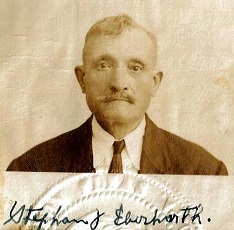 fortunately,
a little information we had gathered back in the late 70’s when a few of his aunts or cousins
were still living. But they had said they didn’t know much because they never spoke of it much. fortunately,
a little information we had gathered back in the late 70’s when a few of his aunts or cousins
were still living. But they had said they didn’t know much because they never spoke of it much.Larry’s grandmother, Theresia, died in the influenza outbreak of 1918 and the children were all still pretty young. Larry’s dad was only 8. The family got split up with various relatives. Larry’s father passed away in 1976. We knew bits and pieces from him that family had been in the Nazareth, Northampton, PA, area and that Larry’s grandfather died shoveling snow in 1941. Larry did not remember ever being to the cemetery or knowing where it was. His father’s sisters all stayed in the Northampton, PA, area, but there had not been a lot of contact in a number of years. So we started searching the internet and using FamilySearch.org to plug in basics that we thought we knew. I say Larry’s dad was guiding my hand when I found the Burgenland Bunch online and signed up for the newsletter. Through correspondence with the BB, we were able to establish that the area his grandparents emigrated from was Neuberg and that they were married at St. Michael. We found that Larry’s grandfather was born in Pornóapáti and some information on Larry’s great aunts and uncles. Interestingly these places were close in geography but were not the names of the towns we had been told. So we began to refocus our search in these new areas. The Burgenland Bunch BH&R had listed Stephen and Theresia and now we knew where they were buried in the US. Once the crazy snow decided to finally stop here in Ohio and we could finally get to PA in April to see Larry’s mom (she is 97), we took a day trip from Allentown to Nazareth. Usually we take her up to the Northampton area where she grew up, but this time, with the help of Mapquest, we went further north and found the Holy Family Church and Cemetery. It is a small cemetery just behind the church. The women in the church office were very helpful. 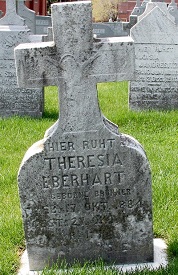 They
actually have a small box of index cards listing, by family, the ones they know are buried
there. They made us copies of the burial certificates that they had. They could not tell us the
exact locations of the graves but felt, given the years we were looking for, that they would be
closer to the church. So Larry and I set out walking a grid, each taking a side. His mom, with
her walker, walked the little driveway and she asked “Did you find the dad? Did you find
Steve?” Indeed, we did, though we found his grandmother, Theresia, first. They
actually have a small box of index cards listing, by family, the ones they know are buried
there. They made us copies of the burial certificates that they had. They could not tell us the
exact locations of the graves but felt, given the years we were looking for, that they would be
closer to the church. So Larry and I set out walking a grid, each taking a side. His mom, with
her walker, walked the little driveway and she asked “Did you find the dad? Did you find
Steve?” Indeed, we did, though we found his grandmother, Theresia, first.There are few family plots. It seemed people were buried as they passed away. So we kept walking and found his grandfather, Stephen, further down. 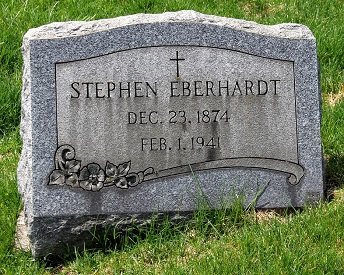 We
were told the baby cemetery was to the side, but we were not able to find the stillborn child as
many of these stones are now unreadable. We think we found a sister who died at age 7, but have
not been able to verify all the information. It was so exciting to actually see the graves and
take photos of their stones as we pieced together another part of the puzzle. We
were told the baby cemetery was to the side, but we were not able to find the stillborn child as
many of these stones are now unreadable. We think we found a sister who died at age 7, but have
not been able to verify all the information. It was so exciting to actually see the graves and
take photos of their stones as we pieced together another part of the puzzle.We also made stops at the Bethlehem Library and the Allentown Library. In searching the internet looking for obituaries, I pulled up The Morning Call site and discovered that the Allentown Morning Call and various Bethlehem newspapers have indexed many obituaries for the years we were interested in and they were accessible on microfilm at the libraries. I was able to find the obituaries for his aunt, Theresa Eberhardt Ressler, and for his grandfather, Stephen John Eberhardt, Sr. They supplied a little bit more information, confirming a few things for us. The Bethlehem library will also do the research for you with a written request and a $5.00 fee per person. Since we came home, we decided to sign up for Ancestry.com and have been able to find, via some established family trees on the site, some sisters of Theresia Brunner Eberhardt who moved on to the Chicago area, thus supplying us with more information. We are now communicating by email and sharing some of the folk stories. It seems we are all having difficulty getting information on Theresia’s father, Joseph Brunner, and mother, Katharina Lorincz Brunner. We keep looking for information on Stephen Eberhardt Sr’s father, Joseph Eberhardt, and mother, Anna Schrammel, but we were told they passed away in Europe. So we will keep digging. We are looking forward to visiting the area we know they emigrated from and learning more about the Burgenland area on our trip. |
5) EMIGRATION FROM THE BURGENLAND TO THE LEHIGH VALLEY (by Mahlon H. Hellerich) [Ed Note: BB member Connie Hellerich Schield, who provided article A Short but Meaningful trip to Burgenland for BB Newsletter No. 239 (31 Jan 2014), also shared some articles written by or about her father, Dr. Mahlon H. Hellerich (1919-2010). Dr. Hellerich was a History professor and Archivist of Lehigh County, PA from 1974 to 1984. As you will see from the article below, he had an avid interest in Burgenland, being married to a daughter of Burgenland emigrants.] 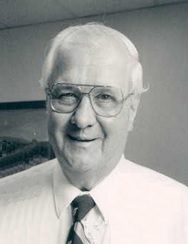 The
Lehigh Valley became the new home of thousands of immigrants from Burgenland in the period
extending from about 1890 to the present. Most immigrants came from southern Burgenland and
settled in Allentown, Coplay, or Northampton. This immigration was part of a mass movement from
Burgenland that began about 1890. Several factors were responsible for this migration. One of
the most important was the rapid increase in population that took place in the last decades of
the nineteenth century as a result of a continued high birth rate and improved medical
procedures, which greatly reduced infant and child mortality. This increase in population placed
a very heavy burden upon a region of small farms and small villages. Many young people could see
that, because of inheritance practices, farms had already been reduced in size to the point at
which they could barely support a family. Further divisions would result in farms too small even
for subsistence living. There was, at that time, but one answer to this condition: migration. The
Lehigh Valley became the new home of thousands of immigrants from Burgenland in the period
extending from about 1890 to the present. Most immigrants came from southern Burgenland and
settled in Allentown, Coplay, or Northampton. This immigration was part of a mass movement from
Burgenland that began about 1890. Several factors were responsible for this migration. One of
the most important was the rapid increase in population that took place in the last decades of
the nineteenth century as a result of a continued high birth rate and improved medical
procedures, which greatly reduced infant and child mortality. This increase in population placed
a very heavy burden upon a region of small farms and small villages. Many young people could see
that, because of inheritance practices, farms had already been reduced in size to the point at
which they could barely support a family. Further divisions would result in farms too small even
for subsistence living. There was, at that time, but one answer to this condition: migration.Indeed, throughout the nineteenth century, men from the Burgenland had been seasonal migrants to other parts of the Austro-Hungarian Empire, where they were employed as farm workers on large estates. Others had migrated to the metropolis of Vienna, which was rapidly becoming a large industrial center, or to Wiener Neustadt, which was emerging as an industrial town. The same demand for labor that existed in Vienna and other large cities of western Europe also existed in the United States. Therefore, the United States became a magnet drawing at first, tens, then hundreds, and finally thousands from the Burgenland to work in its mills and factories. The growing industries—cement, textiles, and metals—of the Lehigh Valley attracted a large number of young men and women who felt it necessary to find and build new homes for themselves in America. Other factors contributed to the migration. In the decade of the nineties, the vineyards in the area of Kukmirn were damaged severely by plant disease. Recovery was slow and painful. Hard times resulted from this catastrophe and convinced many young people that migration was essential. The severe international crises, which occurred in the first decade of this century, threatened a general European War and convinced many young men to migrate to the United States. In the background at all times was the outlook of a frontier people, as the Burgenländers were people to whom migration was not an unusual or exceptional practice. The first migrant to the Lehigh Valley was Josef Urschik, who left his home in the Güssing area in 1884 and who settled in Coplay, where he found employment in the cement mills. In 1888, the migration from Limbach to America began. Among the first migrants from Limbach to Allentown were Karl Krenn and Karl Reichl, followed by two sisters, Julia and Maria Springer. In 1892, Andreas Rossler settled in Allentown. In the parish records of St. Peter's Evangelical Lutheran Church in Allentown were recorded the marriages in 1894 of:
The naturalization records of Lehigh County reveal that, from 1888 through 1901, about
twenty-five men with Burgenland family names applied for or were admitted to American
citizenship. Michael Mirt of Eltendorf migrated to West Bethlehem in l891 and was granted
citizenship in 1906. The number of persons from Burgenland applying for and admitted to
citizenship in Lehigh County increased rapidly from 1900 on. |
6) HISTORICAL BB NEWSLETTER ARTICLES Editor: This is part of our series designed to recycle interesting articles from the BB Newsletters of 10 years ago. However, the June 2005 edition did not have an article I wanted to run again, so once again I went back to the early years of the BB to the August 1998 edition, where a pair of articles talked about terminology from old records, something I find well worth clarifying! THE BURGENLAND BUNCH NEWS - No. 41A August 15, 1998 MORE ON HISTORICAL TERMS (from Fritz Königshofer) (Ed. [Gerry]: As stated previously those old terms appearing on German and Hungarian records are difficult to translate using today's dictionaries. I suggest you make a list of those mentioned here and add them to your genealogical notes. You'll be glad you did when you next encounter them). Fritz writes: "Albert's new information on village terminology painfully reminded me of the mistake I made in translating the manuscript of my great-grandfather, as printed in the recent issue on Poppendorf. I had translated "Hutweiden" as willow trees! I am sorry, at the time I knew no better; I really had no clue at all. Meanwhile, I had found out myself from the Leser articles, which Albert had kindly copied for me, that "Hutweiden" was the term for the "common pastures" of a village, perhaps the southeast German term for the word Allme(i)nde as used in most (?) German lands. I had mixed up "Weide" (willow tree) with "Weide" in the meaning of pasture! Hut means "hat" in German, at least at first glance, somewhat resembling the shape of willow trees. So, this track led me on and on, into ever more erroneous territory. Now I believe that Hut in Hutweide probably refers to "hüten" in the sense of shepherding or herding. This brings me to my wish and question on whether we could try to further clarify the terms used in Burgenland villages of yore. The Leser series also refers to "Rottgründe" as compared to the "Sessionsgründe" of a village, and states that the tithe was still collected from the "Rottgründe" after 1848, although there was no question that tithe no longer applied to the "Sessionsgründe." Perhaps this relates to the question which had been left open in the discussion on terms we had early this year, when Albert reported his puzzlement about the village areas that still required the tithe after 1848. I have no idea about the distinction between Rottgründe and Sessionsgründe. However, the word "Rott..." might refer to "roden" (clearing), and the distinction might derive from when the clearance had been carried out. Sessionsgründe might describe the older, established exploited (farmed, pastured, forested) areas, whereas Rottgründe were areas that had become exploited more recently. [Ed. note (Tom): Hajszan's text on the History of Neuberg mentions a field called Reutäcker, and he relates it to words roden = clearing, and reuten = clear, so Reutäcker referred to (comparatively) recently-cleared land.] The Hutweiden were parts of the village that were jointly used by all inhabitants, although it seems that there was a Hutweide reserved for the farmers of the village, and one for the "Söllner" (smallholders, Hungarian: zsellér). It appears that during the Commassierung (called "Flurbereinigung" in other parts of German lands), the Hutweiden were thrown into the total pool of land for redistribution to individual farmers and thus ceased to exist as commons for the village. Other interesting terms are the "Hotter," probably describing the whole of the village in its borders against neighboring villages [Ed. note (Tom): we have since confirmed this interpretation; the equivalent Hungarian word was határ], possibly called Dorfmark or Gemeindemark in other German lands. Perhaps this is also the same thing as the term Gemeindeflur. Another term was/is "Anger" which might describe a field of grass (or a pasture), but might more specifically mean a bordering area, such as the grass fields bordering the area of cultivation (grain and vegetable fields). You might recall that, in the Poppendorf manuscript, one inhabitant mentioned had the name Angerhacker, which might refer to a family with the name of Hacker, living at the "Anger"-grounds of the village. I am not even 50% sure of the following, but the Hungarian word for Anger might be "dl." [Ed. note (Tom): this "dl." does not seem likely; in Hungarian, pasture = legelo, commons = köznép, and bordering = határos; none resemble "dl." I have heard of Anger referring to a Dorfplatz = village green/commons.] A term I don't recall from the Burgenland, but certainly used a lot in neighboring Styria is "Leiten," typically meaning a pasture on the side (slope) of a mountain or hill. As I had mentioned during the previous discussion we had on the subject, the typical allocation of land to a farmer in newly settled areas in German lands in the Middle Ages was called the Hufe, ranging from about 10 hectares to 20 and more (the "Königshufe"). When I revisited Albert's previous writings about the typical size of a full session in Hungary (16 to 40 Joch or Hold), I was surprised how closely this resembles the typical Hufe (my English dictionary translates the word as "hide", which Webster calls an old English land measure amounting to 24 to 40 hectares, a larger measure than in Germany but still within the same ballpark). I wonder how often I might have missed the boat once again in this write-up, but my intention was to help rekindle this interesting discussion of an area which I think we have not fully nailed down as yet." A FEW MORE TERMS (Albert Schuch answers Steve von Hitritz concerning some church record terms): > "Cerdo sodalis" - "sodalis" is Latin for "journeyman" (in German: "Geselle"), "cerdo" for "tanner" (in German: "Gerber" or "Lederer"); [The SPITZER leather factory / tannery in Eisenstadt was a quite famous one - maybe this person worked there. I'd be interested to know the name of this person or at least where he came from, as my disseration partially deals with the tanneries in this area.] > "ancilla" or "aucilla" usually next to a wife's name. - "ancilla" is Latin for "(maid) servant" (in German: "Magd"); > On the record for Locus Domicilii cum Nro. Domus is either Mons XX or Arx XX where XX is a number. - Eisenstadt has developed from 4 once independent communities: 1) Eisenstadt, 2) Unterberg (the former Jewish Ghetto), independent until 1938, 3) Oberberg (short: "Am Berg"), independent until 1939, 4) Schlossgrund, independent until 1923. "Mons" is Latin for "mountain" (in German: "Berg"), hence in this case will refer to "Oberberg"; "Arx" is Latin for "castle" (in German: "Schloss"), hence refers to the "Schlossgrund" (castle area; under jurisdiction of the Princes Esterhazy until 1848). > On later records in 1880s, Locus Domicilii says Kismarton Mons or Kismarton Arx. And a number. - "Kismarton" is the official Hungarian name for Eisenstadt. The literal meaning is "Small [Saint] Martin" as opposed to "Nagymarton" (German: Mattersdorf, today Mattersburg), literally meaning "Large [Saint] Martin"; for "Mons" and "Arx" see above; The number is always the house number. |
7) ETHNIC EVENTS LEHIGH VALLEY, PA Sunday, July 19: Jägermeister Day at the Coplay Sängerbund. Music by the Josef Kroboth Orchestra. Info: www.coplaysaengerbund.com Sunday, July 19: Reading Liederkranz Singers' Volksfest at the Reading Liederkranz. Music by the Joe Weber Orchestra. Info: www.readingliederkranz.com Saturday, July 26: Reading Liederkranz 160th Anniversary Celebration Kickoff. Info: www.readingliederkranz.com Saturday, July 26: Parish Festival at Holy Family Catholic Church in Nazareth. Music by the Josef Kroboth Orchestra. Info: www.holyfamilyparish.myownparish.com NEW BRITAIN, CT Friday, July 3, 7 pm: Heimat Abend. Austrian Donau Club, 545 Arch Street, $3. Music by Joe Rogers and his band. Friday, July 17, 7:30 pm: Heurigan Abend. Austrian Donau Club, 545 Arch Street, $3. Music by Schachtelgebirger Musikanten. |
8) BURGENLAND EMIGRANT OBITUARIES Elizabeth Metzger (née Harrer)  Elizabeth
Metzger, age 90, of Johnsburg, Illinois, passed away at Hearthstone Manor in Woodstock after
battling Alzheimer's disease for many years. Elizabeth
Metzger, age 90, of Johnsburg, Illinois, passed away at Hearthstone Manor in Woodstock after
battling Alzheimer's disease for many years.Born on April 12, 1925, in Mosonszentpéter (St. Peter am Heideboden), Hungary, she was the daughter of the late Michael and Theresia (Perlinger) Harrer. Elizabeth married Joseph Metzger of Pomáz, Hungary on January 26, 1952, at St. Mary's Catholic Church in McHenry, IL. They had met in Sinsheim, Germany, where they were both displaced following World War II, and later decided to make their future life together in the United States. Elizabeth immigrated to the United States from Germany on February 8, 1950 and Joseph immigrated the following year. Elizabeth's sponsors lived in McHenry, IL, where Elizabeth and Joseph established their first home. They later moved to Johnsburg, IL, where they resided for almost 60 years. Elizabeth worked at Admiral in McHenry when she first came to the United States. Once her children were born, Elizabeth focused on her home life. Elizabeth was known far and wide for her excellent baking and cooking skills, but also enjoyed gardening, crocheting, and her weekly bingo outings with friends. She was also very active at St. John the Baptist Catholic Church in Johnsburg, serving as a Eucharistic minister and helping with the Keenager activities. Elizabeth lived at home until entering Hearthstone Manor, when it became too difficult for her husband to care for her. Joseph visited her daily until he was no longer able to drive. At that point he decided to move into the Assisted Living section at Hearthstone Manor, so they could continue to be together, and he was at her side when she died. Elizabeth is survived by her husband, Joseph; three children, John (Candace) Metzger of Rochester, NY, Paul (Donna) Metzger of Nashua, NH, and Maria (Roger) Zawacki of Johnsburg, IL; and five grandchildren, Emily and Erich Zawacki, Matthew and Margaret Metzger and Mallory (Matthew) Boyd. Visitation will be on Wednesday, June 3, 2015, from 5:00 until 9:00 p.m. at Hamsher Lakeside Funerals and Cremations, 12 North Pistakee Lake Road, Fox Lake, IL 60020. A funeral mass will be on Thursday, June 4, 2015, at 10:00 a.m. at St. John the Baptist Catholic Church, 2302 West Church Street, Johnsburg, IL 60051 with interment to follow. In lieu of flowers, donations may be made to the Alzheimer's Association www.alz.org/donate and/or to Hearthstone Communities www.wclsil.org/tnbci/donate.htm. Published in the Northwest Herald on June 2, 2015 Gisella Lenzser (née Horvath)  Gisella
Lenzser, 91, of Oregon City, Oregon, passed away peacefully in her sleep on June 3, 2015. Gisella
Lenzser, 91, of Oregon City, Oregon, passed away peacefully in her sleep on June 3, 2015.She was born Gisella Horvath in the small town of Győrsövényház (Günzelsbruck), Hungary. The youngest of six children, Gisella married her childhood sweetheart, Josef Lenzser, in 1944. In 1951, they immigrated to the U.S. with daughter, Elizabeth, and son, Frederick. The family had lived in Oregon since 1953, including Mt. Angel, Portland, West Linn and Beavercreek. Gisella worked as a seamstress in a clothing factory. Gisella is survived by her children, Elizabeth Kraft (husband, Ralph) and Frederick Lenzser; grandchildren, Sarah Dorn (husband, Garrick), Joseph Kraft, James Kraft, Kate Molina (husband, Alfredo) and Kellen Hassard; and great-grandchildren, Paige Dorn, Sydney Dorn and Deiva Molina. Gisella was preceded in death by her husband, Josef. Gisella was a loving and devoted wife, mother, grandmother and great-grandmother. She made remarkable pastries. Gisella touched the lives and tastebuds of many and will be truly missed. A rosary will be recited at 10:30 a.m. followed by Mass, reception and graveside service Wednesday, June 10, 2015, at St. John the Apostle Catholic Church, 417 Washington St., Oregon City. Published in The Oregonian from June 5 to June 7, 2015 Lewis Fandl  Lewis
K. Fandl, 104, of Lanark, Pennsylvania, formerly of Limeport and Allentown, died on June 7,
2015. Lewis
K. Fandl, 104, of Lanark, Pennsylvania, formerly of Limeport and Allentown, died on June 7,
2015. He was the husband of the late Helen (Madle) Fandl for over 70 years until her death in 2010. Born in Zahling, Austria, he was the eldest son of the late Lorenz and Mary (Zenz) Fandl. He came to the U.S. in 1923. During his early years of employment he worked in the aircraft industry, both on the east and west coasts. During WW-II he worked for Republic Aircraft on Long Island. With his knowledge of metals, he helped to design and test warplanes including the famous P-47 Thunderbolt. After the war, while employed by Air Products and Chemicals, he was involved in various government experimental projects for the U.S. space program. He retired from the former Lehigh Valley Electronics and Engineering in 1976 after many years of service. His favorite pastime was spent at his farm, a few miles from his residence, where he could be found enjoying the peace and quiet of nature, as it reminded him of his boyhood homestead in Austria. During the 1950s he and his wife hosted summer picnics there for dozens of family, friends and neighbors. Survivors: Daughters, Kathleen (John) Kilian of Florence, SC and Joan Niles of Center Valley; Three grandchildren, Wendy Larish, Beth Strauss, Jeffrey (Tione) Larish; Five great grandchildren, Keryn Anchel, Hanna, Luke and Adele Strauss and Carmen Larish; Sisters, Hilda Eichelberger of PA, Viola (George) Rehrig of PA, and Louise Clark of AR. In addition to his wife, he was predeceased by a daughter and son-in-law, Elaine and David Larish, a granddaughter, Sherry Plante, two sisters, Rose Ritter and Emma Reichelderfer, and three brothers, William, Joseph, and Walter. Services: Mass of Christian Burial, 10:00 AM, Saturday, June 13, 2015 at St. Joseph's Catholic Church, 5050 St. Joseph's Rd., Coopersburg, PA 18036. Viewing: 9:00 - 9:45 AM, Saturday at the church. Contributions: In lieu of flowers, contributions may be made to the church. Published in Morning Call on June 10, 2015 Leo Piplitsch  Leo
J. Piplitsch 79, of Allentown, Pennsylvania, passed away on Tuesday June 23, 2015 in the Lehigh
Valley Hospital. Leo
J. Piplitsch 79, of Allentown, Pennsylvania, passed away on Tuesday June 23, 2015 in the Lehigh
Valley Hospital. Leo was the husband of the late Rosemarie A. (Dittmann) Piplitsch who passed in 2007. Born in Stegersbach, Austria, Leo was the son of the late Leopold and Caroline (Rothen) Piplitsch. Leo worked for the former Bethlehem Steel Corp. for 25 years prior to retiring in 1996. He was a member of Our Lady Help of Christians Catholic Church in Allentown. Leo was a member of the Greater Beneficial Union in Pittsburgh, and the Lehigh Saengerbund. Survivors: Surviving is his son Earl J. Peterson and his wife Kelly and their children; Matthew, Dennis, and Kayla. Services: A Mass of Christian Burial will be celebrated on Friday June 26, 2015 at 10:00 am in Our Lady Help of Christians. Calling will be on Friday from 9:15-9:50 am in the church. Contributions: In lieu of flowers contributions may be made in Leo's memory to his church, 444 N. Jasper St. Allentown, Pa. 18109. Arrangements entrusted to the O'Donnell Funeral Home. Published in Morning Call on June 24, 2015 |
| END OF NEWSLETTER |
NOTICE (Terms and Conditions): The Burgenland Bunch (BB) was formed and exists to assist Burgenland descendants in their research into their heritage and, toward that end, reserves the right to use any communication you have with us (email, letter, phone conversation, etc.) as part of our information exchange and educational research efforts. • If you do not want your communication to be used for this purpose, indicate that it is "confidential" and we will abide by that request. • Correspondents who communicate with the BB without requesting confidentiality retain their copyright but give a non-exclusive license to the BB allowing us to forward to BB members, publish in our monthly newsletter or on our website, and/or subsequently and permanently archive all or parts of such communications. The Burgenland Bunch homepage (website) can be found at: http://www.the-burgenland-bunch.org Burgenland Bunch Newsletter, copyright © 2015 by The Burgenland Bunch All rights reserved. Permission to copy excerpts granted if credit is provided. |
 News
News BB
Houselists: Last month, I announced that the core of the BB Houselists project was
completed (at least one list for each village) and I pointed out that such "completion" "does
not mean we cannot add additional lists for border villages or different time points for
Burgenland villages." I further stated that, "If you have such a list and are willing to
contribute it, we'll be pleased to add it to the collection."
BB
Houselists: Last month, I announced that the core of the BB Houselists project was
completed (at least one list for each village) and I pointed out that such "completion" "does
not mean we cannot add additional lists for border villages or different time points for
Burgenland villages." I further stated that, "If you have such a list and are willing to
contribute it, we'll be pleased to add it to the collection." On
a pass/fail measure, Burgenland students returned a 95.9% pass-rate in German,
90.1% in English and 90.2% in Mathematics. Overall pass-rates for all of Austria
were 96.7% in German, 94.2% in English and 89.5% in Mathematics. Thus
Burgenland's students were below average in the languages and above average in math. More
precisely, among the 9 provinces of Austria, the initial results place Burgenland in last
place in German and in English, and 5th place in Mathematics (beating
Tyrol, Wien, Salzburg, and Vorarlberg; but trailing Oberösterreich, Steiermark, Niederösterreich
and Kärnten).
On
a pass/fail measure, Burgenland students returned a 95.9% pass-rate in German,
90.1% in English and 90.2% in Mathematics. Overall pass-rates for all of Austria
were 96.7% in German, 94.2% in English and 89.5% in Mathematics. Thus
Burgenland's students were below average in the languages and above average in math. More
precisely, among the 9 provinces of Austria, the initial results place Burgenland in last
place in German and in English, and 5th place in Mathematics (beating
Tyrol, Wien, Salzburg, and Vorarlberg; but trailing Oberösterreich, Steiermark, Niederösterreich
and Kärnten). Update
for book "The Burgenländer Emigration to America": Here is this month's update on
purchases of the English issue of the 3rd edition of Dr. Walter Dujmovits' book "Die
Amerika-Wanderung Der Burgenländer."
Update
for book "The Burgenländer Emigration to America": Here is this month's update on
purchases of the English issue of the 3rd edition of Dr. Walter Dujmovits' book "Die
Amerika-Wanderung Der Burgenländer." HUNGARIAN
KIPFLES (from Margaret Graf)
HUNGARIAN
KIPFLES (from Margaret Graf)